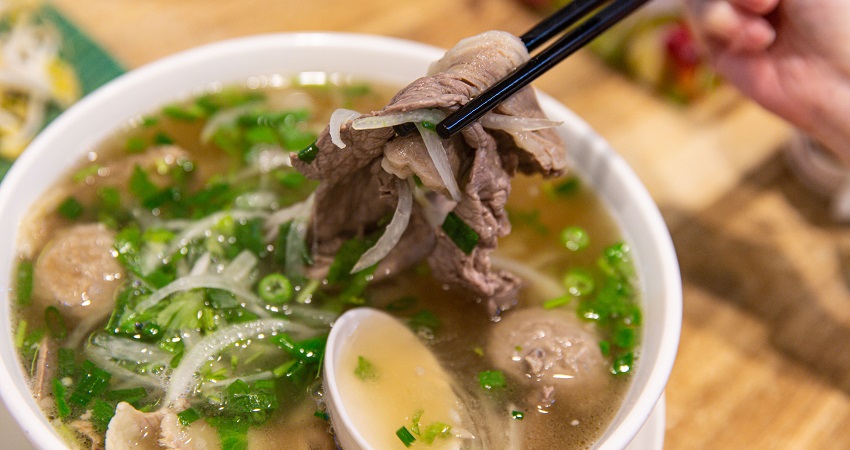Articles
December 10, 2024
Southeast Asian foods are What’s Hot at U.S. restaurants
Culinary forecast explores reasons why chefs and restaurants are gravitating toward this popular cuisine.

Vietnamese Pho is just one of the Southeast Asian foods whose diversity caters to a wide range of tastes.
New research from the National Restaurant Association indicates that some of the top menu trends chefs and restaurateurs are focused on are the cuisines, spices and flavor profiles of Southeast Asia.
According to the just-released 2025 What’s Hot Culinary Forecast, this growth comes in response to U.S. consumer interest in the region’s distinctive foods, especially the ones they can’t easily replicate at home.
Southeast Asian cuisine, with its big and bold flavors, health-conscious appeal, cultural authenticity, and increasing accessibility, is captivating customers everywhere. From Vietnamese Pho to Filippino Chicken Adobo to Korean Bingsu, its diversity caters to a wide range of tastes. Known for vibrant and complex flavor profiles, it often features elements such as citrus, herbs, chili peppers, fish sauce, and coconut milk that create dynamic taste experiences. Additionally, the pickling and fermentation prevalent in some of the preparations present what consumers perceive as health benefits.
“For decades, Southeast Asian foods have ranked among the top global cuisines for American restaurant customers,” says Hudson Riehle, the Association’s senior vice president of research. “And, as the years have progressed, two important trends have occurred concurrently: First, Asian cuisines and their supply chains have grown in diversity and availability. Second, diners and their global palates have become more sophisticated and knowledgeable. As a result, there is a much broader and receptive audience for them.”
Download the 2025 What’s Hot Culinary Forecast here
According to the just-released 2025 What’s Hot Culinary Forecast, this growth comes in response to U.S. consumer interest in the region’s distinctive foods, especially the ones they can’t easily replicate at home.
Foods that are fun…and good for you, too
“Asian cultures, especially those from Korea, the Philippines and Vietnam, to name a few, have captured America’s attention,” says Dr. Chad Moutray, the Association’s vice president of research. Their foods ranked high in this year’s survey, he notes, reflecting the consumer’s desires for “foods that deliver fun experiences and cater to more refined palates, spice, and heat.”Southeast Asian cuisine, with its big and bold flavors, health-conscious appeal, cultural authenticity, and increasing accessibility, is captivating customers everywhere. From Vietnamese Pho to Filippino Chicken Adobo to Korean Bingsu, its diversity caters to a wide range of tastes. Known for vibrant and complex flavor profiles, it often features elements such as citrus, herbs, chili peppers, fish sauce, and coconut milk that create dynamic taste experiences. Additionally, the pickling and fermentation prevalent in some of the preparations present what consumers perceive as health benefits.
“For decades, Southeast Asian foods have ranked among the top global cuisines for American restaurant customers,” says Hudson Riehle, the Association’s senior vice president of research. “And, as the years have progressed, two important trends have occurred concurrently: First, Asian cuisines and their supply chains have grown in diversity and availability. Second, diners and their global palates have become more sophisticated and knowledgeable. As a result, there is a much broader and receptive audience for them.”
The path to popularity
Southeast Asian cuisines, with their balance of sweet, sour, salty and spicy flavors as well as variety of textures, are growing in popularity in America due to a growing appreciation for authentic ethnic flavors, increased accessibility to ingredients, and a rising Asian American population. Here are four reasons why the interest in this cuisine is seen as a trend, rather than a fad.- Increased travel and exposure to Southeast Asian cultures has led to a greater interest in trying authentic dishes. As Americans travel farther, they return home with awakened palates and are more likely to experiment more with the dishes and flavors they’ve experienced on their travels. Also, easy access to Korean and other Southeast Asian entertainment – including cooking shows and contests – exposes consumers to new food on screen, which they then seek out to try in real life.
- The increasing number of Asian Americans in the U.S. have contributed to the wider availability and curiosity about authentic Southeast Asian food.
- Celebrity chefs specializing in Southeast Asian cuisine have further popularized the cuisine through cookbooks and TV shows.
- Many dishes include vegetables and lean protein sources, aligning with modern health trends.
Download the 2025 What’s Hot Culinary Forecast here
Download the report
Download the report
Sign up for our Newsletter
The latest news from the National Restaurant Association, published every other Thursday
By clicking Submit I agree to receive email communications from the National Restaurant Association and agree to our Privacy Policy(Opens in a new window).
